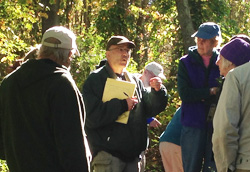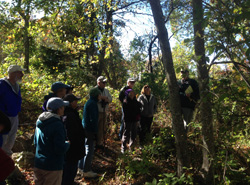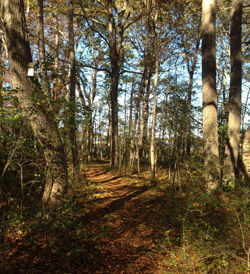Scott Turner reflects on a walk at Canonchet Farm
The Providence Journal, November 11, 2016
Co-explorers of the world around us
 An unconventional walk in the woods renewed my spirit near the end of a disagreeable election season. An unconventional walk in the woods renewed my spirit near the end of a disagreeable election season.
My stroll was as leader of a publicized nature walk in South County, in which I learned as much from participants as they might have picked up from me.
My guess is that no one on the walk was under the age of 50. But they seemed like first graders in terms of curiosity, high spirits and telling of tales.
What are those bright red berries, someone asked? I hadn’t noticed them. They belonged to the native plant, winterberry, I replied, which is a holly that drops its leaves. Winterberry usually grows in wet woods, right where we found it.
Did I know that the young shoots of greenbrier were edible in spring, thorns and all, one person asked? No, I didn’t.
 At some point, the group stopped behind me, staring down. Someone had pointed out both the red and orange colors of maple and tupelo leaves on the ground and the medley of blushes and shapes that the foliage had formed. At some point, the group stopped behind me, staring down. Someone had pointed out both the red and orange colors of maple and tupelo leaves on the ground and the medley of blushes and shapes that the foliage had formed.
A few yards later, the group halted behind me again. This time, somebody drew their attention to a stand of white mushrooms no more than three inches high, delicately stemmed and mop-capped, growing on a log beside the trail.
At a sassafras grove, a participant told the gathering that a mother sassafras tree produced underground shoots that gave rise to seedlings around her. If left alone, these seedlings become saplings and then a grove.
Moreover, said the woman, when the mother sassafras began to wane, the young trees nourished her in return through those same underground shoots.
As a species, humans could learn from sassafras trees about how to take care of one another, she said.
After the walk, I asked the woman to share a reference for the information that sassafras offshoots nourished their ailing mother, as I had never heard of that.
“I have no idea where I read it, unfortunately,” she said. “True or false, I love the idea.”
 I thought of the partially fictional sassafras tale as the floral version of the motto, “one for all and all for one,” and maybe, “united we stand, divided we fall.” I thought of the partially fictional sassafras tale as the floral version of the motto, “one for all and all for one,” and maybe, “united we stand, divided we fall.”
Grounded in disrespect, the election season divided us. On this walk, I found the opposite: a generosity of spirit in which we learned from each other without degrading one another. No one tried to upstage, downgrade, upbraid or degrade. Instead, we coalesced.
For two hours on a fall afternoon, 20 people explored the forest. Each of was both teacher and learner. We used that power to produce something that felt healthy. The experience was a much-welcomed reminder that we were all members of the same flock. It’s called humanity.
Scott Turner’s ( scottturnerster@gmail.com ) nature column appears in The Providence Journal most Fridays.
|